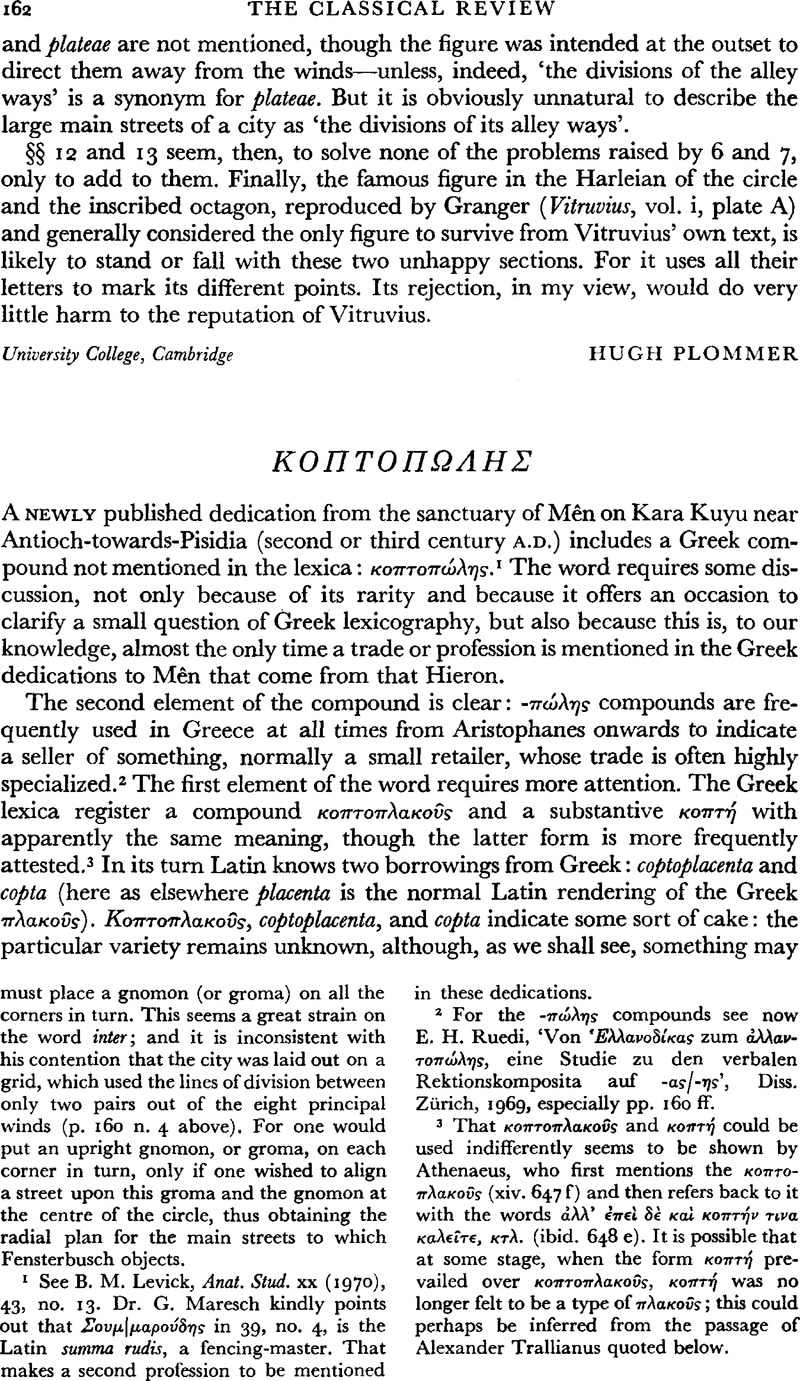No CrossRef data available.
Published online by Cambridge University Press: 27 February 2009

page 162 note 1 See Levick, B. M., Anat. Stud. xx (1970), 43, no. 13Google Scholar. Dr. G. Maresch kindly points out that Σονμ|μαρύδης in 39, no. 4, is the Latin summa rudis, a fencing-master. That makes a second profession to be mentioned in these dedications.
page 162 note 2 For the -πώλης compounds see now Ruedi, E. H., ‘Von Ἑλλανοδίκας zum ἀλλαντοπώλνς, eine Studie zu den verbalen Rektionskomposita auf -ας/-νς’, Diss. Zürich, 1969, especially pp. 160 ff.Google Scholar
page 162 note 3 That κοπτοπλακοῦςand κοπτή could be used indifferently seems to be shown by Athenaeus, who first mentions the κοπτοπλακοῦς (xiv. 647 f) and then refers back to it with the words ἀλλ᾽ ἐπεὶ δὲ καὶ κοπτήν τινακαλεῖε, κτλ. (ibid. 648 e). It is possible that at some stage, when the form κοπτή prevailed over κοπτοπλακοῦς, κοπτή was no longer felt to be a type of πλακοῦς; this could perhaps be inferred from the passage of Alexander Trallianus quoted below.
page 163 note 1 Cf., e.g., Herzog-Hauser, G., R.E. xx (1950), 1894 f., s.v. placenta.Google Scholar
page 163 note 2 Athen. xiv, 648 f: τοῦ δὲ ᾑμῖν παρακειένου μελιπήκτου, referring to the κοπταί just mentioned. Hesychius' text has κοπταίμελίπηκτα, but Latte now emends to κοπταί, comparing Athen., loc. cit.
page 163 note 3 Both these definitions (‘gâteau de sésame pilé’ and ‘pilule’) have found their way into Chantraine's Dict. Ét., s.v. κόπτω C (1).
page 163 note 4 Paralipomena Grammaticae Graecae (Leipzig, 1837), ii. 351 ff.Google Scholar
page 163 note 5 For other feminine formations connected with -ος nouns and adjectives in the post-Ptolemaic period, see Palmer, L. R., A Grammar of the Post-Ptolemaic Papyri i (London, 1946), 64.Google Scholar
page 164 note 1 Herzog-Hauser, art. cit., suggests that κοπτή was a form of marzipan. The O.E.D. defines marchpane or marzipan (the German form seems to have ousted the English at the beginning of this century) as ‘a paste of pounded almonds, sugar, etc., made up into small cakes or moulded into ornamental forms’, and some cookery books use ‘almond paste’ as a synonym for ‘marzipan’. The present passage of Alex. Trall, and other references show that the ancient product admitted a much wider range of seeds or nuts, but the O.E.D. cites a work of 1616 which says that ‘marchpanes are made of verie little flower, but with addition of greater quantitie of Filberds, Pine Nuts, Pistaces, Almonds, and rosed Sugar’. We could perhaps say that κοπτή was a kind of marchpane.
page 165 note 1 Cf. Thuc. i. 126: θύονσι … θύματα ἐπιχώρια, which the scholiast explains: τινὰ πέμματα εἰς ζώων μορφὰς τετυπωμένα ἔθυον. Dover, , Aristophanes, Clouds (Oxford, 1968), 205CrossRefGoogle Scholar, suggests that the scholiasts' explanation of ἁμαξίς was the product of centuries of inflation. It might have been prompted too by the Thucydides passage.
page 165 note 2 Cf., e.g., Orth, . R.E. xi (1922), 2088 ff., s.v. Kuchen (with a section on Opferkuchen)Google Scholar. Still useful is the long appendix on Pemmatologia Sacra added by Lobeck to his Aglaophamus (ii. 1050 ff.).
page 165 note 3 It is possible that the passage from Artcmidorus quoted above implies that κοπταί too, likeπυραμοί etc., were used in feasts and sacrifices: cf. ἐπὶ δὲ τῶν ἄλλων πεμμάτων τῶν ἐν ἑορταῖς καὶ θυσίαις γινομένων, κτλ.